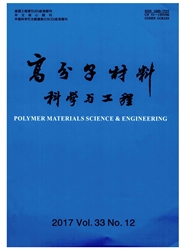

 中文摘要:
中文摘要:
基于流变学基本方程和Phan Thien—rranner(PTT)本构方程,建立了矩形截面双层型材口模气辅共挤出和传统共挤出的三维非等温粘弹有限元模型,使用粘弹应力分离法(EVSS)、非协调流线迎风法(SU)等有限元方法数值模拟了两种聚合物熔体在口模内的流动过程,得到了气辅共挤和传统共挤层间界面的三维形貌图和剪切应力分布,对比分析了两种共挤界面的粘性包覆和剪切应力分布情况,研究结果表明,气辅共挤可使粘性包围程度减小60%以上,界面剪切应力峰值减小30%以上,气辅共挤将能有效改善共挤制品层厚分布均匀性及界面稳定性。
 英文摘要:
英文摘要:
A 3D non-isothermal viscoelastic finite element (FEM) model was established based on fundamental equations of rheology and Phan Thien-Tanner(PTT) constitutive model for a rectangular shaped bilayer co-extrusion polymer profile. Then, numerical simulations of the flow of two polymer melts in gas-assisted and conventional coextrusion process were performed respectively by means of finite element methods such as elasitc-viscous-split-stress (EVSS) method, streamline-upwind(SU) method and so on. Through these simulations, it is obtained the 3D morphology and the shear stress distribution of the interfaces of gas-assisted co-extrusion and conventional coextrusion. Finally, the encapsulation and shear stress distribution of the two co-extrusion interfaces were compared and analyzed. The results show that the gas-assisted co-extrusion can reduce the degree of encapsulation by more than 60%, and reduce the peak shear stress by more than 30%. Gas-assisted co-extrusion can improve the thickness uniformity of the multi-layers of co-extrusion products and enhance the interracial stability effectively.
 同期刊论文项目
同期刊论文项目
 同项目期刊论文
同项目期刊论文
 期刊信息
期刊信息
